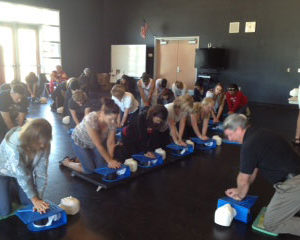Everything changed in 2008. American Heart Association (AHA) releases these new CPR guidelines included a new technique called “Hands Only CPR”. The media ate this up. Article after article stating that it is no longer important to breathe for victims. Hands-Only are just as good. They were excited to tell everyone there is a new style of CPR in town. What they fail to share is, This Hands-Only compression technique is not for everyone.
In fact, it was actually targeting the untrained public. Those who have never had any formal training. This was aimed at those folks who would normally just stand around after someone collapsed and do nothing. NOW they can immediately begin chest compressions with little or no training.

Also, the media would have you believe that Hands-Only CPR is for everyone. It is not! Below is the short list of who needs breathing along with compressions. In other words, Real CPR.
You need to perform CPR with breathing for:
- Infants
- Children
- Choking
- Drownings
- Electrocutions
- Drug overdoses
- Un-witnessed collapse of anyone
If you are trained in CPR, it is suggested you manage the airway and perform ventilations during CPR. It is the preferred method. If you are a un-trained sign up for a CPR/First Aid class today.
Compressions only CPR is not the preferred method.
But, it is better than nothing for adults following a witnessed collapse. It is believed that the victim may have up to two minutes of air in the lungs that can be circulated. Your first responders, the Fire Department paramedics are still 6-8 minutes away from arrival to your scene. That would leave your victim without oxygen to the brain and other vital organs for over 4-6 minutes. Remember in 3-4 minutes brain damage can occur, and after 4 minutes brain damage can become permanent.
How to perform the “Hands-Only CPR”
To perform Hands-Only CPR you only need to confirm that the victim is not breathing. Call 9-1-1. An easy rule of thumb to determine breathing is if the victim isn’t moving, they are not breathing. Of course, the best indicator is to watch for Chest and/or abdominal rise in the victim.
Next, align hands with fingers interlocked on victims sternum (breastbone) at the mid-nipple line. Simply begin continuous CPR compressions at a rate of 100 per minute. Push a full 1/3 depth. The American Heart Association slogan is “Push hard, Push fast”.
CPR Face Shield/Barrier
As much as I would prefer that everyone would perform mouth to mouth, I also realize there is a level of risk folks may not want to take. Even though mouth to mouth by itself is low risk, that changes when the victim has fallen (sudden collapse) and hit their head. Along with being injured, or ill and dying those risks dramatically increase due to the possibility of blood or stomach contents being in the mouth.
By carrying Personal Protective Equipment (PPE’s) one can eliminate the risk to performing CPR. With a one-way valve in a barrier mask and a pair of gloves and an antimicrobial wipe, you stand very well protected.
The solution is to carry a CPR face shield/barrier mask, vinyl gloves, and antimicrobial wipe. This combination keeps the rescuer safe during CPR and provides the maximum benefit for the victim.

